Invisalign – Springdale, AR
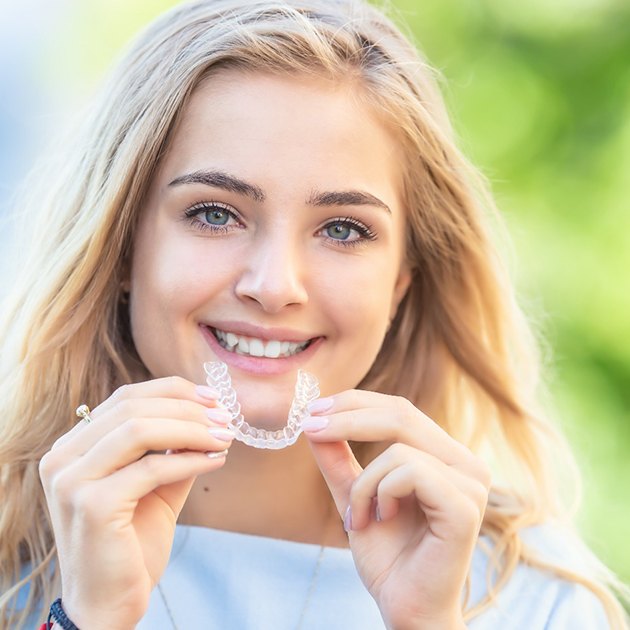
The Clear Alternative to Brackets & Wires
Even if you want a straighter smile, you might hesitate to get orthodontic work. After all, many don’t like the idea of sticking brackets and wires on their teeth. Dealing with that situation can seem like a hassle! However, metal braces aren’t the only way to align pearly whites. Invisalign in Springdale is an excellent alternative. With it, Dr. Bollin and the rest of Sunset Avenue Dental can straighten your grin subtly. Just keep reading to learn more about it, or book a visit for details.
How Invisalign Works

If you don’t already know, Invisalign is a series of clear, plastic aligners. Its trays gradually straighten teeth with micro-movements, which shift each tooth into the proper position. Once the aligners finish their work, they’ll give you the straight smile of your dreams!
Of course, you have to comply with treatment guidelines for Invisalign to work. As such, you must wear each aligner for 7-14 days before moving to the next one. Furthermore, the trays should be worn 22 hours daily – anything less will lead to alignment delays. So long as you follow these rules, you can expect a straight grin in only 12-18 months.
Invisalign vs. Other Orthodontic Treatments
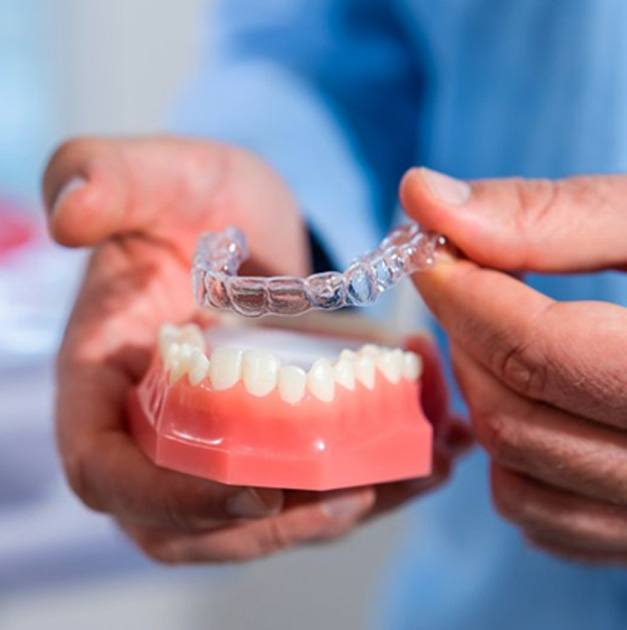
With today’s orthodontic treatments, you’ll expect to choose from a variety of ways to effectively straighten your smile. However, although Invisalign is similar to other solutions, it does come with separate advantages you might not find with other options. On top of being virtually invisible to others, the material is also designed for enhanced comfort and precise tooth movements. Learn more about what differentiates Invisalign from other orthodontic treatments.
Learn More About Invisalign vs. Other Orthodontic Treatments
Indications for Invisalign
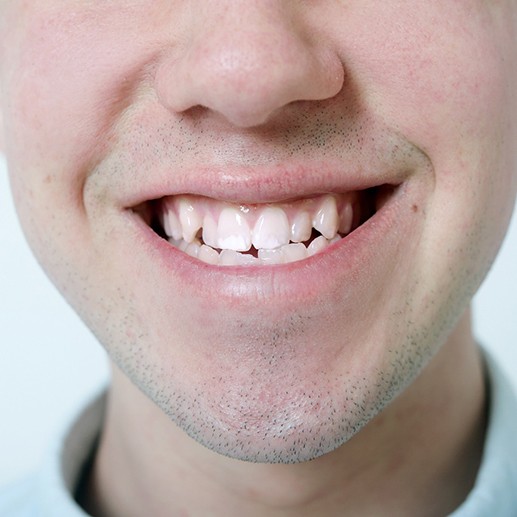
Generally speaking, Invisalign is ideal for patients with mild to moderate tooth misalignment. Its trays are most often used to address the following issues:
Learn More About Cases Treatable with Invisalign
Crowded Teeth
When teeth crowd together, they harm the health and look of your smile. For instance, you’ll likely see the bottom ones protruding and rubbing up against the upper ones excessively.
Still, Invisalign can keep such things at bay. Since its trays gently guide your smile, it corrects crooked and overcrowded teeth.
Gaps Between Teeth
Your appearance and health are at risk when you suffer gaps between teeth.
Thankfully, Invisalign also fixes tooth gaps. As its trays work, the relevant spaces are eventually closed.
Bite Alignment
When you have a poor bite, your grin looks worse and puts undue pressure on your jaw joints. In fact, the latter pressure can cause TMJ disorder, teeth grinding, or clenching.
However, Invisalign can solve many bite issues – underbites, overbites, crossbites, etc.
Benefits of Invisalign
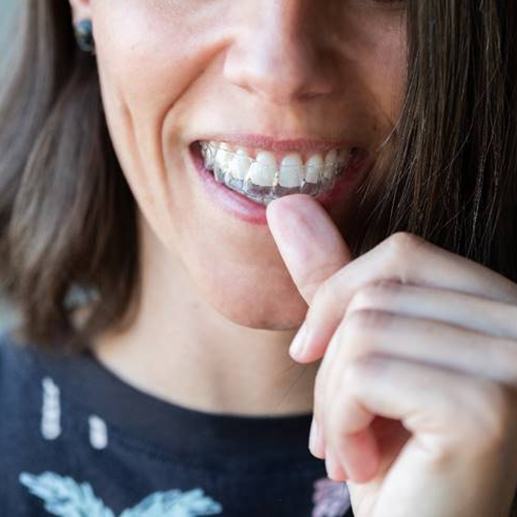
Invisalign is truly a premium orthodontic treatment. Patients are attracted to it because of the many benefits it offers. In fact, in some ways, it is much more advantageous than traditional metal braces! What are some specific benefits that you might enjoy throughout your treatment? Below, we talk about a few. If you want to learn more about anything you discover here, feel free to reach out to our friendly and knowledgeable team.
Discreet Appearance

One of the most common complaints about traditional metal braces is the fact that they are very noticeable. Invisalign, in contrast, is quite discreet. Although the aligner trays are not totally invisible, they are subtle. They are unlikely to be the first thing that onlookers notice about you, so you can enjoy improved confidence throughout your entire treatment period.
Enhanced Comfort

Invisalign aligner trays are made of smooth plastic that rests comfortably against soft oral tissues. There are no metal wires and brackets to rub against your tongue or cheeks and cause irritation. Plus, Invisalign is somewhat gentler than traditional braces, so you can expect less soreness overall as your teeth gradually get shifted into their ideal positions.
No Dietary Restrictions

Invisalign aligners are easy to remove. At mealtimes, you can simply take them out of your mouth and enjoy whatever food you are craving — even if that food would be off-limits with traditional metal braces! After you eat, all you have to do is attend to your oral hygiene, rinse your aligners, and place them back in your mouth.
Easy Oral Hygiene
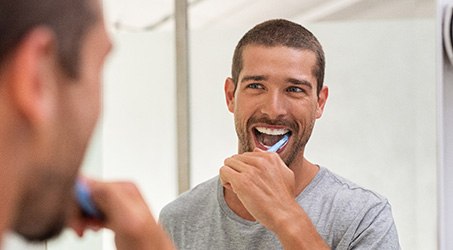
Brushing and flossing can be somewhat challenging with traditional metal braces. Navigating around all those brackets and wires requires special instruments and can take quite a bit of time! With Invisalign, you can simply remove your aligners and brush and floss using normal techniques. Keeping the aligners clean is also easy and simple.
Fewer Follow-Up Appointments

On average, braces require that you visit a dentist 20 to 40 times throughout treatment. In contrast, aligners only need about 6 to 12 follow-ups. Plus, the appointments are usually brief, often lasting no more than 15 – 30 minutes. You can expect Invisalign to have a minimal impact on your daily life!
Reliable Results and Non-Invasive Treatment
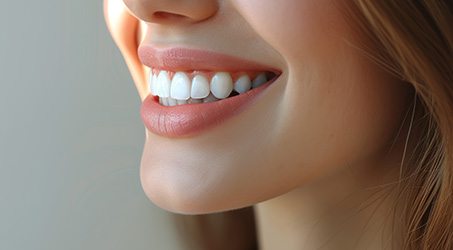
Invisalign is a state-of-the-art treatment that combines technology and time-tested orthodontic techniques to produce reliable tooth movements. It consistently delivers desirable results, and it does so in a way that has minimal effects on your daily routine. As long as you comply with some simple instructions, it is likely that you will enjoy a very smooth treatment journey!
Living with Invisalign
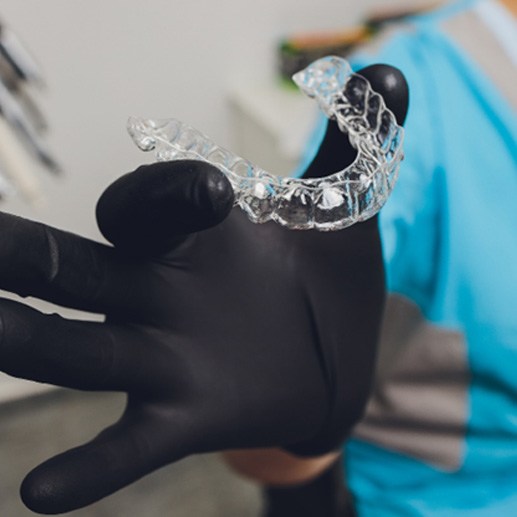
A key benefit of choosing Invisalign treatment over traditional braces is that clear, removable trays have less of a day-to-day impact on your life than metal brackets and wires that are affixed to your teeth. Invisalign only requires making small adjustments to your existing habits, which makes the process of undergoing orthodontic treatment easier and more streamlined. We invite you to learn a little more about what living with your new aligners will look like below.
Wearing Your Trays

Even though your trays are removable, it doesn’t mean that your treatment is part-time. Just like braces, it’s crucial to wear your aligners for most of the day, every day. In fact, the recommended minimum time to wear them is 20 to 22 hours a day, only taking them out whenever you clean your teeth and eat. When you leave your trays out of your mouth for longer than a few hours, it will only add more time to your treatment.
Cleaning Your Aligners

After each time you take your aligners out of your mouth, before you put them back in, you will need to rinse them with lukewarm water. This will help minimize any cross-contamination of whatever surface you placed them on to your mouth.
It’s important to thoroughly clean them using a soft-bristled toothbrush and clear hand soap after every time you eat or drink anything besides water. Finally, you’ll want to make sure that you maintain good dental hygiene by brushing and flossing your teeth after each of your meals. This will keep food debris from becoming trapped between your trays and teeth.
Eating & Drinking

There aren’t many restrictions when it comes to Invisalign treatment, but there are a couple adjustments you will need to make to avoid damaging an aligner. Before you eat or drink anything besides water, it’s important to remove your trays. This will keep them from becoming misshapen, discolored, or otherwise altered, which could halt your treatment until you receive a new tray from your dentist in Springdale.
Losing or Damaging a Tray

If you accidentally damage or lose one of your Invisalign aligners, don’t worry! Simply call our team at Sunset Avenue Dental as soon as possible. Depending on how long until you switch to the next series of aligners in your treatment, we may either recommend coming in for a replacement or moving forward with your next trays.
Routine Check-Ins
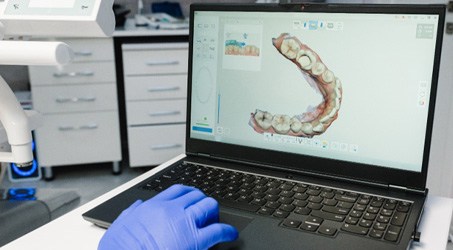
Throughout your Invisalign treatment, you will need to visit our office every six to eight weeks for routine check-ins. These appointments are very short, typically around 15 minutes. We will check to make sure that your teeth are moving as anticipated and provide you with the next sets of aligners in your treatment.
Invisalign Teen
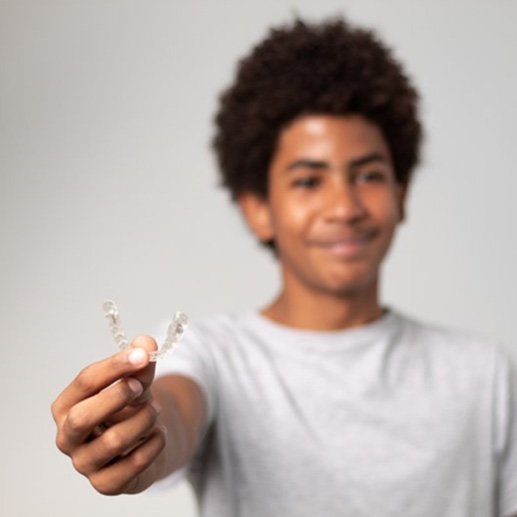
If you have a middle or high schooler who’s self-conscious about their smile, then you might consider having them undergo Invisalign Teen. Instead of metal brackets and wires, your teenager will be able to wear smooth plastic aligners that are much more comfortable while straightening their pearly whites. Completely removable and effective, this treatment can help set your teen up for a healthier and more confident smile.
Read More About Invisalign Teen
Understanding the Cost of Invisalign
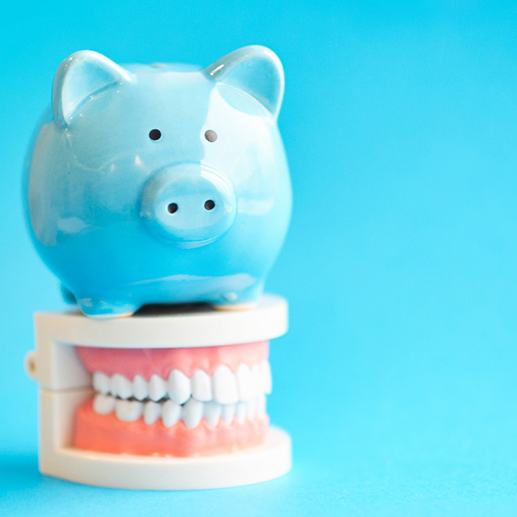
Invisalign trays are customized for a specific mouth, so treatment price varies by patient. Fortunately, you can get a precise estimate during your consult with Dr. Bollin! At this appointment, he will assess various factors of your situation, including your misalignment’s severity. Whatever your situation, trust that we’ll guide you through the financing process. Our team is here to help you get an accurate estimate and review all the financial solutions available.
Factors That Affect the Cost of Invisalign
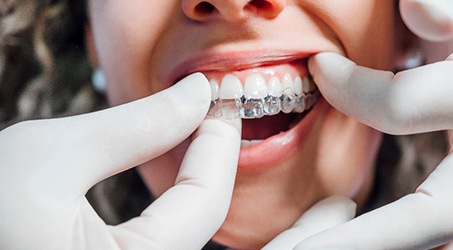
As mentioned above, there isn’t a one-size-fits-all Invisalign treatment, so there isn’t a one-size-fits-all cost. Before determining the price, Dr. Bollin will need to assess:
- The severity of your misalignment
- How many trays are needed to straighten your teeth
- If rubber bands or any other additional accessories are needed
- If you need to straighten one or both arches of your teeth
Of course, those are just factors that will impact the initial price. Once you begin your clear aligner treatment, you will need to follow all of the guidelines (like wearing your aligners for 20-22 hours a day) to avoid falling off-track with your plan. In the case that you do, new trays will need to be made, which will require additional time and money.
Invisalign vs. Smile Direct Club™: Which Costs More?
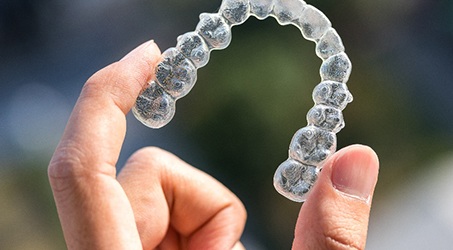
Since mail-order aligner companies lead with a lower upfront cost, it’s not surprising that many patients wonder if they should opt for Invisalign or an alternative. In short, while Invisalign may come with a higher upfront cost, it’s well worth it. Unlike mail-order options, Invisalign starts with a thorough initial exam to determine whether or not you’re a candidate. Furthermore, Invisalign cases are supervised by licensed professionals that conduct periodic check-ins to ensure your teeth are tracking properly. Lastly, and perhaps most importantly, Invisalign has support from professional organizations like the American Dental Association, and the same cannot be said for mail-order alternatives.
Does Dental Insurance Cover Invisalign?

There are some cases where the answer is “yes!” Although some plans don’t include any orthodontic coverage, others include a once-in-a-lifetime benefit that will cover a portion of the cost. So, don’t hesitate to review the fine print on your dental plan to find out. You can also get in touch with our team; we’re proud to be in-network with many popular providers like Aetna, BlueCross BlueShield, Cigna, and Delta Dental.
Options for Making Invisalign Affordable

In addition to welcoming dental insurance, Sunset Avenue Dental has an in-house membership plan, happily accepts flexible financing through CareCredit, and offers periodic specials. So, don’t hesitate to talk to us about the cost of Invisalign! We’d be more than happy to review each financial solution, answer any questions you have, and help you determine which one is best for you.
Invisalign FAQs

Want to learn more about Invisalign in Springdale? We’re here to help! From “Does Invisalign give you a lisp?” to “How do I clean my aligners?” our team has responded to a few of the most frequently asked questions we hear from patients below. If you can’t find the answer you’re looking for, then don’t hesitate to get in touch with our team.
Does Invisalign Give You a Lisp?
Over the years, a misconception has surfaced that Invisalign gives you a lisp. Not only do the large majority of patients not have a lisp, but the ones that do have a short adjustment period can rest easy knowing it’s temporary. Furthermore, there are several things you can do to speed up the learning curve, including reading out loud and repeating the more difficult words when you come across them.
What Happens After Invisalign?
While Invisalign can guide your teeth into their properly aligned positions, you’ll need a retainer to keep them in place. Typically, patients are encouraged to wear them as much as possible while their teeth “set” (usually around six months). After that, we will give you the green light to wear them solely at night. Since orthodontic relapse can happen in the short and long-term, it’s important to make this a life-long habit.
How Do I Clean My Invisalign?
Patients often overcomplicate the process of cleaning their aligners. In reality, it just takes a few simple steps! First, rinse your trays with clean, room temperature water. Second, use a soft-bristled toothbrush to gently scrub each surface. Third: rinse your trays again. That’s it! If your aligners have begun to discolor and you want to give them a deeper clean, you can also soak them in a mixture of water and cleaning crystals (which are in your welcome kit).
How Long Does Invisalign Take?
On average, Invisalign treatment timelines are 12-18 months. Since every treatment plan is completely personalized, however, the exact length can change. For example, patients with minor misalignment can complete their series of trays in just six months. On the other hand, patients struggling with more moderate malocclusion may need more than 18 months. Don’t worry – an estimate of your treatment timeline will be provided at your consultation!
Can You Eat with Invisalign?
Eating with your aligners in is an absolute no-no since it can damage your aligners, delaying your treatment timeline in the process. Fortunately, you can eat whatever you’d like after you remove them! With that said, it’s always a good idea to exercise caution with hard, sticky, and chewy foods, especially if you have attachments. You should also keep your consumption of sugary foods to a minimum since they increase your chances of developing cavities. Instead, focus on eating lots of vitamin-rich foods that will keep your smile healthy from the inside out!
What are Invisalign Attachments?
You can think of Invisalign attachments as small, “extra” pieces that help patients with more complicated alignment issues. Sometimes this means bonding a small bump to your teeth that will grip their surface as the aligners shift their positions. Other times this could mean adhering a “button” that will allow for rubber bands.
If you need an Invisalign attachment to effectively straighten your teeth or solve your bite misalignment, rest assured – the bonding and adhesive materials won’t damage your pearly whites, and the attachments are designed so that you can still remove your aligners. You’ll be able to enjoy all the same benefits as a patient without attachments.
Can You Get Invisalign After Braces?
It depends on your needs, but Invisalign is able to correct the vast majority of dental misalignment cases – including cases where the patient previously had braces. In fact, we may recommend a combination treatment that includes braces, then transitions you to Invisalign.
Another reason a patient might want an Invisalign treatment is that their teeth were effectively straightened by braces but slipped back out of alignment over time. Invisalign is a great way to receive a more comfortable, second orthodontic treatment!
How Do I Take Off Invisalign Trays?
With practice, removing Invisalign becomes second nature. At first, however, it might be surprisingly tricky to take them out. Start by making sure your hands are dry, then continue with the following steps:
- Slide your fingers to the back of your mouth. Pinch the aligners on one side, right around your molars.
- Keep pinching and gently tugging to loosen the aligners, then switch to the other side and repeat.
Once you get the molars free, it’s much easier to pry your aligner the rest of the way out. Avoid tugging too hard, and remember that applying pressure is more effective than pulling.
If you’re having trouble removing your aligners, consider purchasing an Invisalign PulTool or OrthoKey. They’re specifically designed to help with this process, and might be worth the investment!
Can You Smoke During Invisalign Treatment?
Smoking is a difficult habit to keep up if you want to complete your Invisalign treatment on time and maintain invisible trays. Cigarette smoke and nicotine vapor will stain Invisalign if you smoke while wearing them, but if you smoke without wearing them, you might not meet the 20–22-hour wear time.
Tobacco products are also not good for your overall oral health, as they greatly increase your risk of gum disease, among other things. We encourage patients to quit smoking while undergoing Invisalign treatment, but we also understand that this habit can be hard to break. Let us know if you need help; we have plenty of resources, and would be happy to share them with you!
